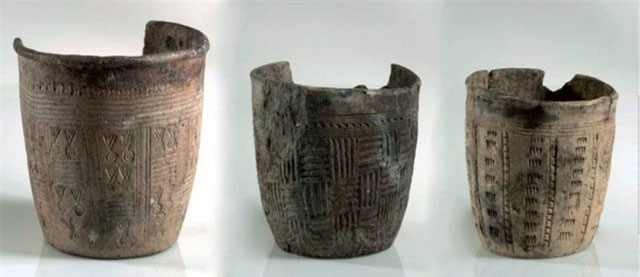Stone woven into cloth: From mummy's shroud to powerful weapons
From the time of ancient Egypt, people discovered a unique technique of "weaving cloth from stone", which was later used by the US military as a weapon.
From the Egyptian mummy shroud
Asbestos (from the French asbestos /amjɑ̃t/), also written as asbestos or Asbestos in English, is a group of six naturally occurring silicate minerals that can be found on every continent on Earth. soil.
The mineral's characteristic is that it is composed of long, thin fibrous crystals, each consisting of millions of tiny fibers that can be released by abrasion.

Egyptian mummy shroud made of asbestos.
From the dawn of history, ancient people discovered the advantages of asbestos and applied it to everyday life. Archaeologists have found evidence that: Since 4,000 BC, long hair-like fibers of asbestos have been used to make lamp wicks and candle wicks.
The fabric woven from asbestos is extremely durable, heat resistant and fire resistant. Between 2,000 and 3,000 BC, the mummified bodies of Egyptian pharaohs were carefully wrapped in layers of asbestos cloth to prevent damage.
In Finland, clay pots containing asbestos fibers have also been found dating from 2,500 BC. This mineral fiber has the effect of increasing the durability of the bottle and especially helping the bottle to resist fire.
In 456 BC, Herodotus (484 BC-425 BC), one of the greatest historians of all time, mentioned the use of asbestos shrouds to prevent the ashes of the dead from mixing with the ashes of the tops. fire on the cremation pyre.

Clay pot containing asbestos fibers in Finland.
Some researchers believe that the origin of the word "asbestos" may be traced back to the Latin expression "amiantus", which means unpolluted or unpolluted.
The ancient Romans woven asbestos fibers into cloth and used it to make tablecloths or napkins. Every time towels got dirty, the Romans would throw them into the great burning fire.
Somehow, the cloth remained intact, even brighter than the original.
Not only exploiting asbestos's unique properties, the Greeks and Romans also documented its harmful effects on humans. The Greek geographer Strabo (63 BC-23 AD) documented "lung disease" in slaves weaving asbestos.
The Roman historian, naturalist, and philosopher Pliny the Elder (23/24 BC – 79 AD) wrote of the "sickness of slaves" and described how workers had to use a kind of mask respirator made from the bladder of a goat or sheep intended to provide protection from inhalation of asbestos fibres.
State-of-the-art weapons of the US military
In fact, asbestos manufacturing was not a developed industry until the late 1800s, when the Industrial Revolution broke out.
Asbestos' resistance to chemicals, heat, water and electricity makes it an excellent material for steam engines, turbines, boilers, ovens and generators. Asbestos' ductile properties also make it an important catalyst in the construction industry.

Image in the asbestos factory in the 1960s-1970s.
Despite all efforts by researchers to safely produce and use asbestos, asbestos remains a great danger to human health. The World Health Organization (WHO) has sufficient human and experimental evidence to classify all types of asbestos as human carcinogens.
This material can be the cause of deadly diseases such as asbestosis, mesothelioma and lung cancer.
Asbestos is most dangerous when it breaks. At that time, asbestos will release microscopic fibers into the air. Because asbestos fibers are difficult to break down, our body is not strong enough to resist once they get into the lungs or other body tissues. From there gradually destroy the human respiratory system.

Asbestos fibers under the microscope.
Since the mid-twentieth century, asbestos products have been widely used in the US military because of their heat-insulating and fire-resistant properties. Every branch of the armed forces uses asbestos in the construction of ships, tanks, trucks, planes, barracks and other structures.
However, according to Asbestos.com, exposure to asbestos in the military has left thousands of US veterans with lung cancer or mesothelioma after retirement.
- New hypothesis about Turin shroud
- There have been more than 500,000 people booking tickets
- Clean wash for Turin shroud
- Ancient weapons of destruction
- Controversy around the
- Revealing techniques for manufacturing ancient weapons from 77,000 years ago
- Proof of the blood of Jesus on the shroud of Turin
- Display the shroud of Turin at the Italian church
- Found woven fabric 2,700 years
- Sweden returned the pre-Inca shroud to Peru
- The Turin shroud will be on display in 2015
- Images of Jesus childhood
 Discovered an ancient centipede fossil 99 million years old
Discovered an ancient centipede fossil 99 million years old Discovered bat-like dinosaurs in China
Discovered bat-like dinosaurs in China Discovered a 200-year-old bronze cannon of the coast
Discovered a 200-year-old bronze cannon of the coast Discover 305 million-year-old spider fossils
Discover 305 million-year-old spider fossils A carcinogen that was once banned in Japan and the United States, many people still come into contact with it every day without knowing it.
A carcinogen that was once banned in Japan and the United States, many people still come into contact with it every day without knowing it.  Using artificial intelligence (AI) in the fight against cancer caused by asbestos
Using artificial intelligence (AI) in the fight against cancer caused by asbestos  WHO sends a letter to the Prime Minister proposing to ban asbestos
WHO sends a letter to the Prime Minister proposing to ban asbestos  Two poisonous substances in Chinese heat-keeping bottles kill people very quickly
Two poisonous substances in Chinese heat-keeping bottles kill people very quickly  Asbestos pain of Asia
Asbestos pain of Asia  There will be 6,600 cases of cancer if using asbestos by 2030
There will be 6,600 cases of cancer if using asbestos by 2030 